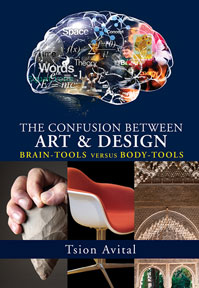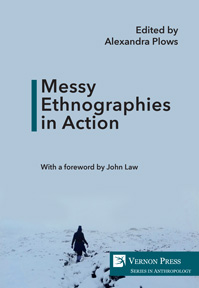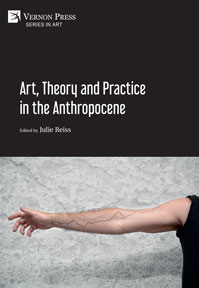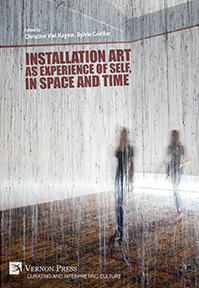Art as experience of the living body / L’art comme experience du corps vivant
An East/West dialogue / Un dialogue Orient/Occident
Christine Vial Kayser (Ed.)
by Alice Dupas (École Normale Supérieure de Lyon, France), Aya Kamperis (CARU (Contemporary Arts ReSearch Unit)), Tetsuya Kono (Rikkyo University, Tokyo, Japan), Alaner Imamoglu (Osmangazi University in Eskisehir, Turkey), Simon Morley (Dankook University, South Korea), Anna Chiara Sabatino (University of Salerno, Italy), Giorgia Ciampi (University of Exeter), Giovanna Colombetti (University of Exeter), Gustavo E. Subero (Imperial College London), Katarina Voigt (TUM School of Engineering and Design, Germany), Lauren Weingarden (Florida State University), Matthew Pelowski (Vienna Cognitive Science Hub, Austria), Corinna Kühnapfel (University of Vienna, Austria), Pascale Weber (Sorbonne School of Arts, France), Zélia Chueke (Universidade Federal do Paraná, Brazil)
Purchase this book
(click here to change currency)
This book analyses the dynamic relationship between art and subjective consciousness, following a phenomenological, pragmatist and enactive approach.
It brings out a new approach to the role of the body in art, not as a speculative object or symbolic material but as the living source of the imaginary. It contains theoretical contributions and case studies taken from various artistic practices (visual art, theatre, literature and music), Western and Eastern, the latter concerning China, India and Japan.
These contributions allow us to nourish the debate on embodied cognition and aesthetics, using theory–philosophy, art history, neuroscience–and the authors’ personal experience as artists or spectators. According to the Husserlian method of “reduction” and pragmatist introspection, they postulate that listening to bodily sensations–cramps, heartbeats, impulsive movements, eye orientation–can unravel the thread of subconscious experience, both active and affective, that emerge in the encounter between a subject and an artwork, an encounter which, following John Dewey, we deem to be a case study for life in general.
Ce livre analyse la relation dynamique entre l’art et la conscience subjective, selon une approche phénoménologique, pragmatiste et enactive. Il vise à faire émerger une nouvelle approche du rôle du corps dans l’art, non pas comme objet spéculatif ou matériau symbolique, mais comme source vivante de l’imaginaire. Les contributions théoriques et les études de cas sont prises à diverses pratiques artistiques (arts visuels, théâtre, littérature et musique), occidentales et orientales, ces dernières concernant la Chine, l’Inde et le Japon.
Selon la méthode husserlienne de « réduction », en écho à l’introspection pragmatiste, les textes témoignent que l’écoute des sensations corporelles – crampes, battements de cœur, mouvements pulsionnels, orientation des yeux – mises en jeu par l’œuvre, permet de dénouer le fil de l’expérience inconsciente, à la fois kinesthésique et affective, qui émerge dans la rencontre entre un sujet et une œuvre d’art, une rencontre comprise, à la manière de Dewey, comme un cas d’école de la vie en général.
List of figures and table / Liste des figures et tableau
ART AS EXPERIENCE OF THE LIVING BODY
AN EAST/WEST DIALOGUE
Editor’s introduction
Christine Vial Kayser
Héritages UMR9022 (CNRS, Cergy Paris University), France
Part I: Theoretical framework
Chapter I.1 Conceptual frame and methodology
Christine Vial Kayser
Héritages UMR9022 (CNRS, Cergy Paris University), France
Chapter I.2 The ‘participant’’s body in aesthetic experience and ‘sense-making enactivism’
Alice Dupas
École Normale Supérieure de Lyon, France
Chapter I.3 The body as a phenomenological site of (non)being in the art of Zen/Gen
Aya Kamperis
CARU (Contemporary Arts ReSearch Unit)
Chapter I.4 Kata and katachi in Japanese philosophy
Tetsuya Kono
Rikkyo University, Tokyo, Japan
Part II: The living body as a mirror between inner and outer self: A liberating strategy
Chapter II.1 The living body as an elsewhere
Alaner Đmamoğlu
Eskisehir Osmangazi University, Turkey
Chapter II.2 “We are in the midst of reality responding with joy”: The paintings of Agnes Martin and attuning to the living body
Simon Morley
Dankook University, South Korea
Chapter II.3 Acting bodies: Aesthetic and therapeutic agency within a cinematic dispositive
Anna Chiara Sabatino
University of Salerno, Italy
Part III: The living body in performance as an integrative gaze
Chapter III.1 Zeami’s concept of riken no ken or the birth of the transcendental subject
Tetsuya Kono
Rikkyo University, Tokyo, Japan
Chapter III.2 Enacting affectivity: The psychophysical training of śṛṅgāra in Gopal Venu’s Navarasa Sādhanā
Giorgia Ciampi
University of Exeter
Giovanna Colombetti
University of Exeter
Chapter III.3 Drag portraiture and socio-political lived bodies in Alexander Apóstol’s Régimen: Dramatis Personae
Gustavo E. Subero
Imperial College London
Part IV: Art as relationship between body, self, space and matter
Chapter IV.1 On being moved: Experiencing art and architecture as an invitation to corporeal resonance
Katarina Voigt
TUM School of Engineering and Design, Munich, Germany
Chapter IV.2 Embodying the photographic image: Charles Marville’s Old Paris and New Paris series
Lauren S. Weingarden
Florida State University
Matthew Pelowski
Vienna Cognitive Science Hub, Austria
Corinna Kühnapfel
University of Vienna, Austria
Chapter IV.3 Living is a performance (and vice versa)
Pascale Weber
Paris 1 Panthéon-Sorbonne University (School of Arts), France
Chapter IV.4 The soul at fingertips
Zélia Chueke
Universidade Federal do Paraná, Curitiba, Brazil
List of contributors
Index (personal names)
Index (concepts)
L’ART COMME EXPERIENCE DU CORPS VIVANT
UN DIALOGUE ORIENT/ OCCIDENT
Introduction
Christine Vial Kayser
Héritages UMR9022 (CNRS, Cergy Paris University), France
Partie I : Cadre théorique
Chapitre I.1 Cadre théorique et méthodologique
Christine Vial Kayser
Héritages UMR9022 (CNRS, Cergy Paris University), France
Chapitre I.2 Le corps du « participant » dans la réponse esthétique et l’énactivisme sense-making
Alice Dupas
École Normale Supérieure de Lyon, France
Chapitre I.3 Le corps comme lieu phénoménologique de la production du (non)être dans l’art zen/Gen
Aya Kamperis
CARU (Contemporary Arts ReSearch Unit)
Chapitre I.4 Kata et katachi dans la philosophie japonaise
Tetsuya Kono
Rikkyo University, Tokyo, Japon
Partie II : Le corps vivant comme un miroir entre intérieur et extérieur : une stratégie libératrice
Chapitre II.1 Le corps vivant comme un ailleurs
Alaner Đmamoğlu
Eskisehir Osmangazi University, Turquie
Chapitre II.2 « Nous sommes au coeur de la réalité et y répondons avec joie ». Les peintures d’Agnes Martin et l’harmonie avec le corps vivant
Simon Morley
Dankook University, Corée du Sud
Chapitre II.3 Le corps acteur : agentivité esthétique et thérapeutique au sein d’un dispositif cinématographique
Anna Chiara Sabatino
Université de Salerne, Italie
Partie III : Le corps vivant dans la performance : un tremplin pour un regard intégrateur
Chapitre III.1 Le concept de riken no ken de Zeami ou la naissance du sujet transcendantal
Tetsuya Kono
Rikkyo University, Tokyo, Japon
Chapitre III.2 La mise en acte de l’affectivité : la formation psychophysique au śṛṅgāra dans le Navarasa Sādhanā de Gopal Venu
Giorgia Ciampi
University of Exeter
Giovanna Colombetti
University of Exeter
Chapitre III.3 Alexander Apóstol Régimen : Dramatis Personae. Portraits de drags, corps vécu et sociopolitique
Gustavo E. Subero
Imperial College London
Partie IV : L’art comme relation entre le corps, soi, l’espace et la matière
Chapitre IV.1 Être (é)mû : vivre l’art et l’architecture comme une invitation à la résonance corporelle
Katarina Voigt
TUM School of Engineering and Design, Munich, Allemagne
Chapitre IV.2 Incarner l’image photographique : la série du Vieux Paris et du Nouveau Paris de Charles Marville
Lauren S. Weingarden
Florida State University
Matthew Pelowski
Vienna Cognitive Science Hub, Autriche
Corinna Kühnapfel
University of Vienna, Autriche
Chapitre IV.3 Vivre est une performance (et réciproquement)
Pascale Weber
Université de Paris 1 Panthéon-Sorbonne (École des arts), France
Chapitre IV.4 L’âme au bout des doigts
Zélia Chueke
Universidade Federal do Paraná, Curitiba, Brésil
Liste des auteurs
Index des noms propres
Index des noms communs
Christine Vial Kayser (PhD, HDR) is an art historian and museum curator (emeritus). She is an Associate researcher with Héritages (CYU) and a member of the Doctoral School 628 - AHSS. Her research relates to the capacity of art to transform representations within an individual and in the collective mind, through embodied, mnemonic, and affective processes, in a global, comparative (East/west context). She works at the crossroads of art theory, anthropology, and neuroaesthetics.
Christine Vial Kayser (PhD, HDR) est historienne de l'art et conservatrice de musée (émérite). Elle est chercheur associé à Héritages (CYU) et membre de l’ED 628 - AHSS. Ses recherches portent sur la capacité de l’art à transformer les représentations au sein d'un individu et dans le cadre collectif, à travers des processus incarnés, mémoriels et affectifs, dans un contexte global et comparatif (Est/Ouest). Elle travaille au croisement de la théorie de l'art, de l'anthropologie et de la neuroesthétique.
Grounded/modal cognition, art as energy, living/lived body, body-mind, quale, autopoietic, embodied action, participatory/interactive art, relational aesthetics, social body, First-/third-person experience, mushin (no-mind), ma, no-self, Noh, riken no ken (distant gaze), Zeami, Aristotle, choreography, ergonomy, performance, rhythm, soul,
Anthropology of nature, environment, memory, projection, somatic adjustments, affect, Charles Marville, empirical aesthetics, gaze, haptics, Haussmann, photography, projection
Architecture, Joseph Beuys, dance, Siri Hustvedt, somatic practice, resonance, Helmut Rosa.
Alexander Apóstol, drag, Merleau-Ponty, male/female binary, political portrait, representation,
Affectivity, Indian theatre, Navarasa S?dhan?, psychophysical acting, rasa, Gopal Venu, Philipp Zarrilli.
Agency, autism, camera, narrative medicine, self-representation (selfie), self-other binary.
Agnès Martin, François Jullien, Lakoff/Johnson, inner and outer landscape, Subject-Self binary, schizophrenia.
Abject, Asl? Erdo?an, Bataille, eroticism, the body in Muslim culture, travel literature.
Body techniques, Don Ihde, Kata/Katachi, kendo, Miki, Minamoto, Noh theatre, Saegusa, Zeami.
Butoh, in-betweenness (Ma/Gen), mushin (no-mind), ningen, postphenomenology, Watsuji, Zen arts
See also
Bibliographic Information
Book Title
Art as experience of the living body / L’art comme experience du corps vivant
Book Subtitle
An East/West dialogue / Un dialogue Orient/Occident
ISBN
978-1-64889-606-4
Edition
1st
Number of pages
794
Physical size
236mm x 160mm

![Art as experience of the living body / L’art comme experience du corps vivant [Hardback]](/file/20587/c83cad67af56edad53ae41d49d1d6096/1684310015.jpg)






